charging Citroen JUMPER RHD 2015.5 2.G Owner's Manual
[x] Cancel search | Manufacturer: CITROEN, Model Year: 2015.5, Model line: JUMPER RHD, Model: Citroen JUMPER RHD 2015.5 2.GPages: 276, PDF Size: 8.88 MB
Page 9 of 276
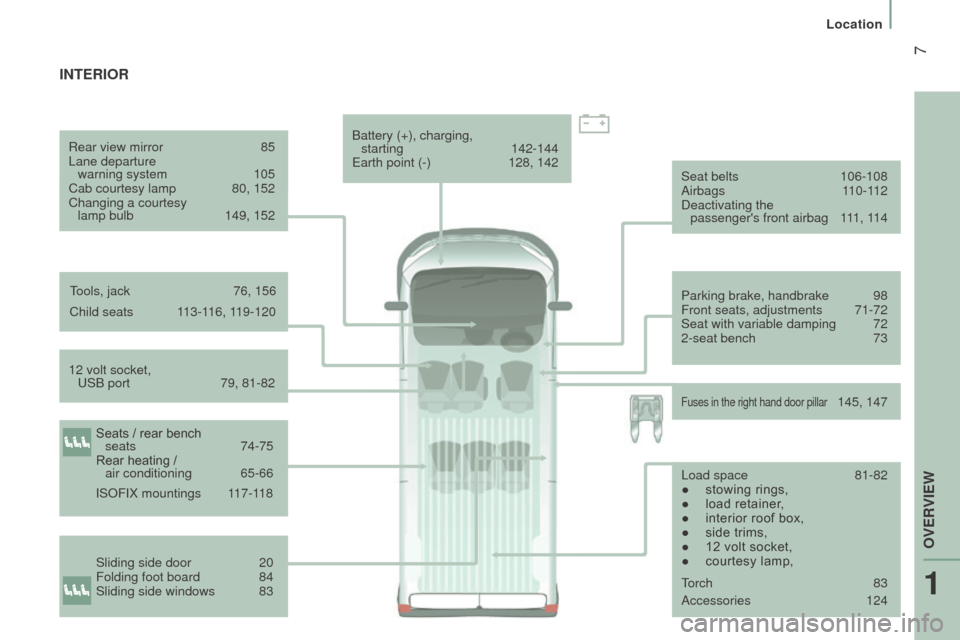
7
Seat belts 106-108
Airbags 110-112
Deactivating the passenger's front airbag
1
11, 114
Parking brake, handbrake
98
Front seats, adjustments
71-72
Seat with variable damping
72
2-seat bench
73
Child seats
1
13-116, 119-120
12 volt socket, USB port
79, 81-82 Battery (+), charging,
starting
142-144
Earth point (-)
128, 142
Fuses in the right hand door pillar 145, 147
IntErIOr
Seats / rear bench
seats 74-75
Rear heating /
air conditioning
65-66
Sliding side door
20
Folding foot board
84
Sliding side windows
83
Rear view mirror
85
Lane departure warning system
105
Cab courtesy lamp
80, 152
Changing a courtesy lamp bulb
149, 152
ISOFIX mountings
1
17-118
Tools, jack
76, 156
Accessories
124
Load space
81-82
●
stowing rings,
●
load retainer
,
●
interior roof box,
●
side trims,
●
12 volt socket,
●
courtesy lamp,
T
orch 83
1
OVERVIEW
Location
Page 27 of 276
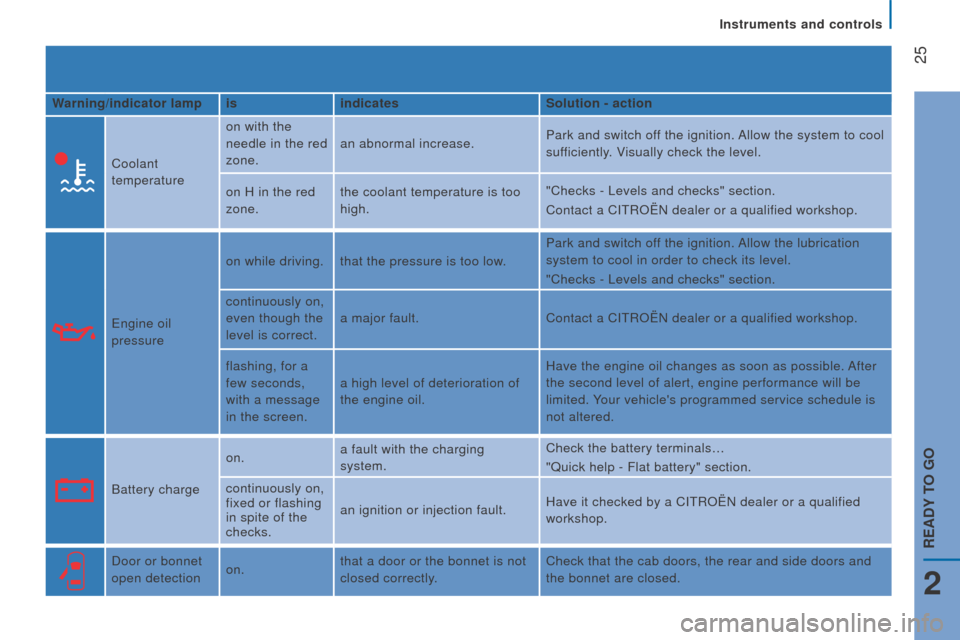
25
Warning/indicator lampisindicates Solution - action
Coolant
temperature on with the
needle in the red
zone.
an abnormal increase.
Park and switch off the ignition. Allow the system to cool
sufficiently. Visually check the level.
on H in the red
zone. the coolant temperature is too
high. "Checks - Levels and checks" section.
Contact a CITROËN dealer or a qualified workshop.
Engine oil
pressure on while driving. that the pressure is too low.
Park and switch off the ignition. Allow the lubrication
system to cool in order to check its level.
"Checks - Levels and checks" section.
continuously on,
even though the
level is correct. a major fault.
Contact a CITROËN dealer or a qualified workshop.
flashing, for a
few seconds,
with a message
in the screen. a high level of deterioration of
the engine oil. Have the engine oil changes as soon as possible. After
the second level of alert, engine performance will be
limited. Your vehicle's programmed service schedule is
not altered.
Battery charge on.
a fault with the charging
system. Check the battery terminals…
"Quick help - Flat battery" section.
continuously on,
fixed or flashing
in spite of the
checks. an ignition or injection fault.
Have it checked by a CITROËN dealer or a qualified
workshop.
Door or bonnet
open detection on.that a door or the bonnet is not
closed correctly. Check that the cab doors, the rear and side doors and
the bonnet are closed.
2
rEAdY tO GO
Instruments and controls
Page 85 of 276
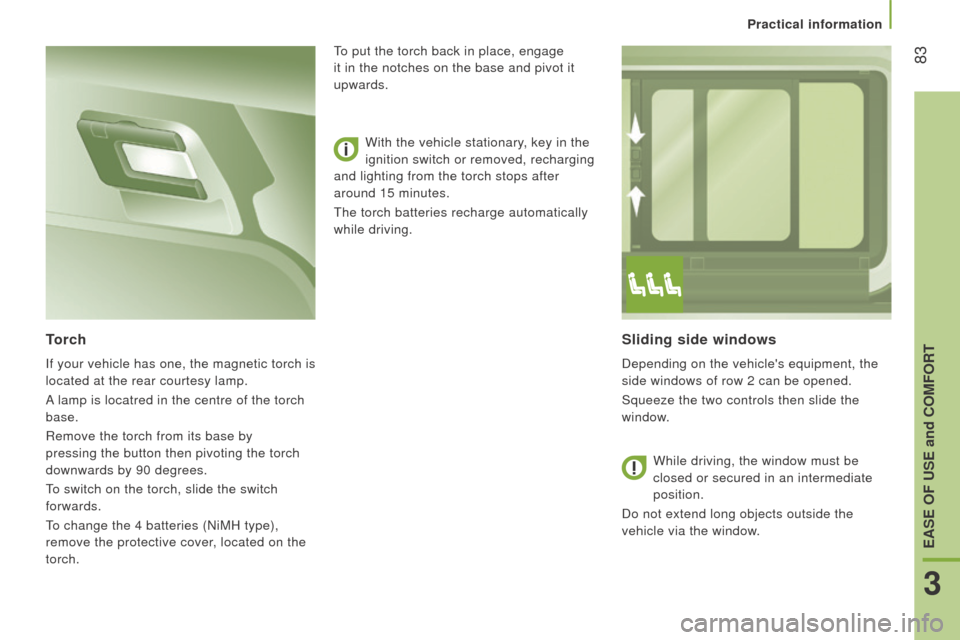
83
Sliding side windows
Depending on the vehicle's equipment, the
side windows of row 2 can be opened.
Squeeze the two controls then slide the
window.
torch
If your vehicle has one, the magnetic torch is
located at the rear courtesy lamp.
A lamp is locatred in the centre of the torch
base.
Remove the torch from its base by
pressing the button then pivoting the torch
downwards by 90 degrees.
To switch on the torch, slide the switch
forwards.
To change the 4 batteries (NiMH type),
remove the protective cover, located on the
torch.With the vehicle stationary, key in the
ignition switch or removed, recharging
and lighting from the torch stops after
around 15 minutes.
The torch batteries recharge automatically
while driving. To put the torch back in place, engage
it in the notches on the base and pivot it
upwards.
While driving, the window must be
closed or secured in an intermediate
position.
Do not extend long objects outside the
vehicle via the window.
3
EASE OF uSE and cOMFOrt
Practical information
Page 145 of 276
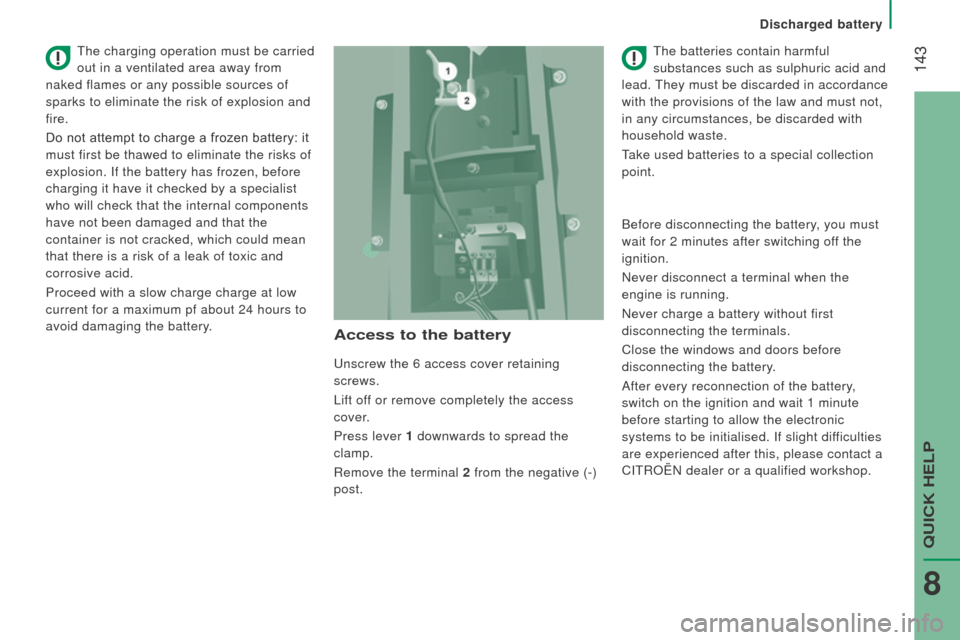
143
Access to the battery
Unscrew the 6 access cover retaining
screws.
Lift off or remove completely the access
cover.
Press lever 1 downwards to spread the
clamp.
Remove the terminal 2 from the negative (-)
post. The batteries contain harmful
substances such as sulphuric acid and
lead. They must be discarded in accordance
with the provisions of the law and must not,
in any circumstances, be discarded with
household waste.
Take used batteries to a special collection
point.
The charging operation must be carried
out in a ventilated area away from
naked flames or any possible sources of
sparks to eliminate the risk of explosion and
fire.
Do not attempt to charge a frozen battery: it
must first be thawed to eliminate the risks of
explosion. If the battery has frozen, before
charging it have it checked by a specialist
who will check that the internal components
have not been damaged and that the
container is not cracked, which could mean
that there is a risk of a leak of toxic and
corrosive acid.
Proceed with a slow charge charge at low
current for a maximum pf about 24 hours to
avoid damaging the battery. Before disconnecting the battery, you must
wait for 2 minutes after switching off the
ignition.
Never disconnect a terminal when the
engine is running.
Never charge a battery without first
disconnecting the terminals.
Close the windows and doors before
disconnecting the battery.
After every reconnection of the battery,
switch on the ignition and wait 1 minute
before starting to allow the electronic
systems to be initialised. If slight difficulties
are experienced after this, please contact a
CITROËN dealer or a qualified workshop.
Discharged battery
QUICK HELP
8
Page 146 of 276
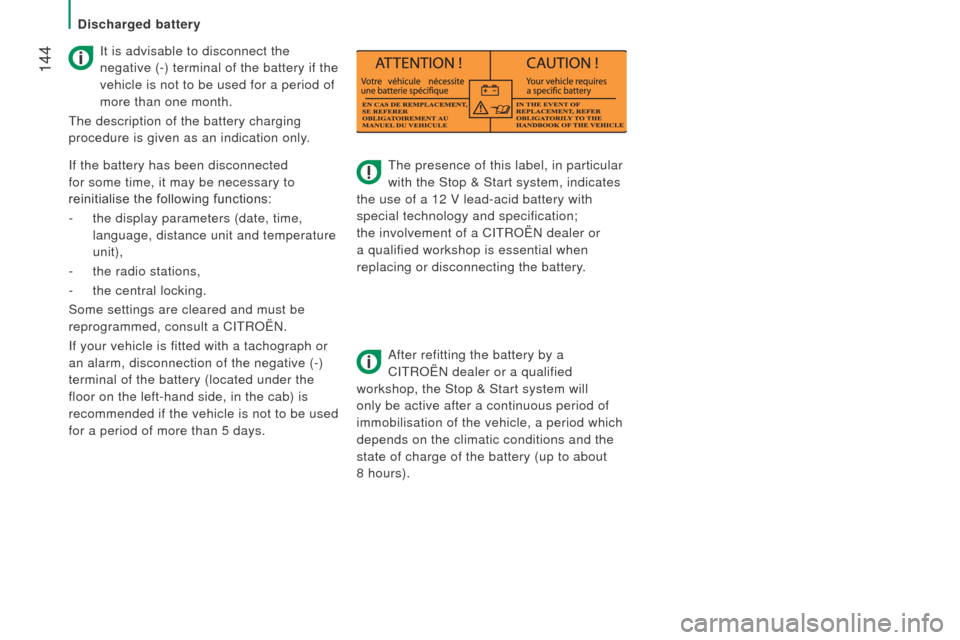
144
The presence of this label, in particular
with the Stop & Start system, indicates
the use of a 12 V lead-acid battery with
special technology and specification;
the involvement of a CITROËN dealer or
a qualified workshop is essential when
replacing or disconnecting the battery.
After refitting the battery by a
CITROËN dealer or a qualified
workshop, the Stop & Start system will
only be active after a continuous period of
immobilisation of the vehicle, a period which
depends on the climatic conditions and the
state of charge of the battery (up to about
8 hours).
It is advisable to disconnect the
negative (-) terminal of the battery if the
vehicle is not to be used for a period of
more than one month.
The description of the battery charging
procedure is given as an indication only.
If the battery has been disconnected
for some time, it may be necessary to
reinitialise the following functions:
-
the display parameters (date, time,
language, distance unit and temperature
unit),
-
the radio stations,
-
the central locking.
Some settings are cleared and must be
reprogrammed, consult a CITROËN.
If your vehicle is fitted with a tachograph or
an alarm, disconnection of the negative (-)
terminal of the battery (located under the
floor on the left-hand side, in the cab) is
recommended if the vehicle is not to be used
for a period of more than 5 days.
Discharged battery
Page 185 of 276
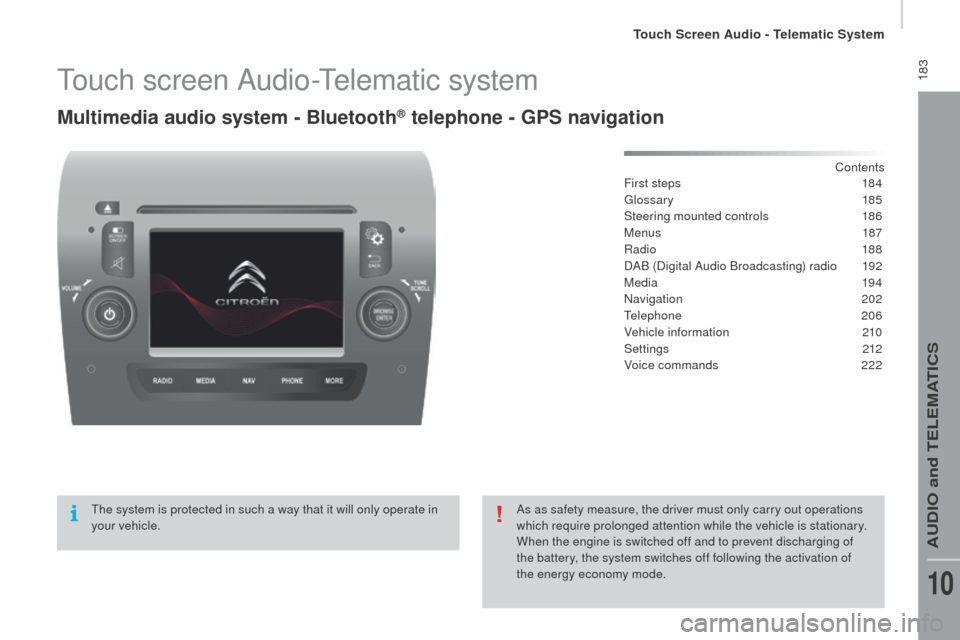
183Touch screen Audio-Telematic system
Multimedia audio system - Bluetooth® telephone - GPS navigation
Contents
First steps
1 84
Glossary
185
Steering mounted controls
1
86
Menus
187
Radio
188
DAB (Digital Audio Broadcasting) radio
1
92
Media
19 4
Navigation
2
02
Telephone
206
Vehicle information
2
10
Settings
212
Voice commands
2
22
The system is protected in such a way that it will only operate in
your vehicle. As as safety measure, the driver must only carry out operations
which require prolonged attention while the vehicle is stationary.
When the engine is switched off and to prevent discharging of
the battery, the system switches off following the activation of
the energy economy mode.
Touch Screen Audio - Telematic System
AUDIO and TELEMATICS
10
Page 200 of 276
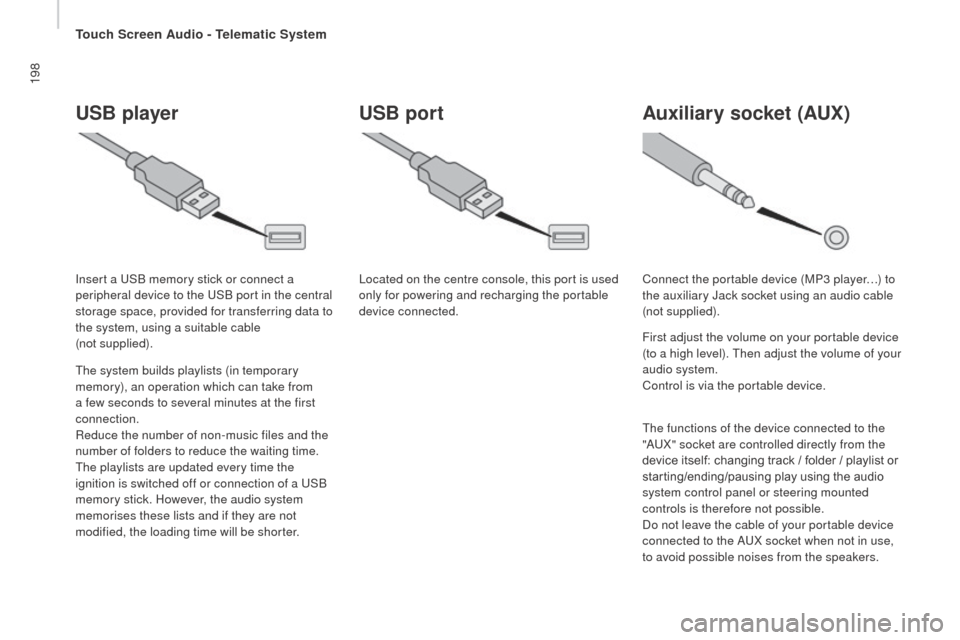
198
uSB player
The system builds playlists (in temporary
memory), an operation which can take from
a few seconds to several minutes at the first
connection.
Reduce the number of non-music files and the
number of folders to reduce the waiting time.
The playlists are updated every time the
ignition is switched off or connection of a USB
memory stick. However, the audio system
memorises these lists and if they are not
modified, the loading time will be shorter. Insert a USB memory stick or connect a
peripheral device to the USB port in the central
storage space, provided for transferring data to
the system, using a suitable cable
(not supplied).
Auxiliary socket (Aux)
Connect the portable device (MP3 player…) to
the auxiliary Jack socket using an audio cable
(not supplied).
Located on the centre console, this port is used
only for powering and recharging the portable
device connected.
uSB port
First adjust the volume on your portable device
(to a high level). Then adjust the volume of your
audio system.
Control is via the portable device.
The functions of the device connected to the
"AUX" socket are controlled directly from the
device itself: changing track / folder / playlist or
starting/ending/pausing play using the audio
system control panel or steering mounted
controls is therefore not possible.
Do not leave the cable of your portable device
connected to the AUX socket when not in use,
to avoid possible noises from the speakers.
Touch Screen Audio - Telematic System
Page 233 of 276
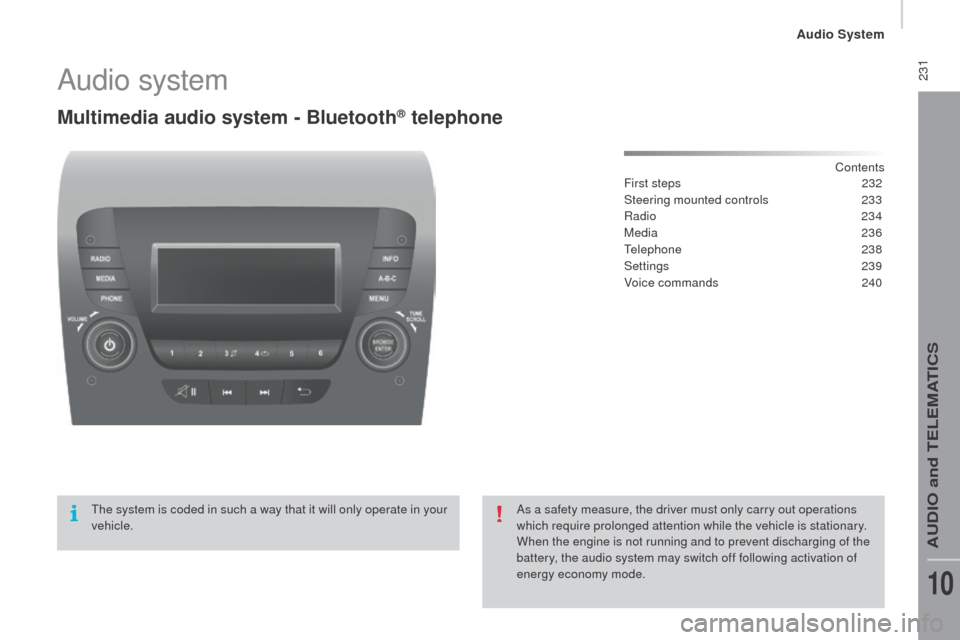
231Audio system
Multimedia audio system - Bluetooth® telephone
Contents
First steps 2 32
Steering mounted controls
23
3
Radio
234
Media
236
Telephone
2
38
Settings
2
39
Voice commands
2
40
The system is coded in such a way that it will only operate in your
vehicle. As a safety measure, the driver must only carry out operations
which require prolonged attention while the vehicle is stationary.
When the engine is not running and to prevent discharging of the
battery, the audio system may switch off following activation of
energy economy mode.
Audio System
AUDIO and TELEMATICS
10
Page 238 of 276
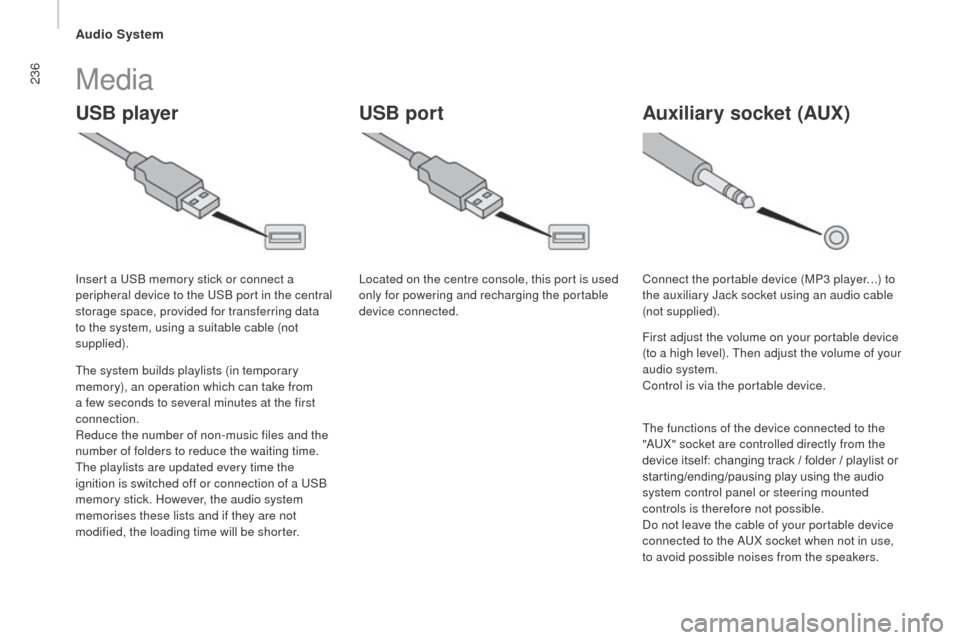
236
uSB playerAuxiliary socket (Au x)uSB port
Media
The system builds playlists (in temporary
memory), an operation which can take from
a few seconds to several minutes at the first
connection.
Reduce the number of non-music files and the
number of folders to reduce the waiting time.
The playlists are updated every time the
ignition is switched off or connection of a USB
memory stick. However, the audio system
memorises these lists and if they are not
modified, the loading time will be shorter. Insert a USB memory stick or connect a
peripheral device to the USB port in the central
storage space, provided for transferring data
to the system, using a suitable cable (not
supplied). Located on the centre console, this port is used
only for powering and recharging the portable
device connected.
Connect the portable device (MP3 player…) to
the auxiliary Jack socket using an audio cable
(not supplied).
First adjust the volume on your portable device
(to a high level). Then adjust the volume of your
audio system.
Control is via the portable device.
The functions of the device connected to the
"AUX" socket are controlled directly from the
device itself: changing track / folder / playlist or
starting/ending/pausing play using the audio
system control panel or steering mounted
controls is therefore not possible.
Do not leave the cable of your portable device
connected to the AUX socket when not in use,
to avoid possible noises from the speakers.
Audio System